
One Last Swim


The coral reef and the rainforest are both incredible places for biodiversity. Even though the reef is dominated by animals and the forest dominated by plants, both have fundamental living structures that provide the basis for life. Both are nutrient-poor environments, but between trees and corals both environments have living things that host other organisms. Corals build up space in the ocean where other organisms can live, and tree canopies in the forest host birds, arthropods, and many others. These spaces also provide the basis for many trophic levels, which is why they contribute so much to biodiversity.
In terms of what I observed, I have found that the rainforest had much less open space than the reefs. In the water we saw patch reefs, which were dense clusters of high diversity interspersed with more or less barren sand, but the rainforest was packed everywhere except for the man-made trails. In both cases, it was hard or rare to spot a lot of megafauna, but both places were teeming with life in any case.
Three things that I learned from this trip are that there is hope for the environment, field research is hard but rewarding, and that the rainforest is less grueling than I thought. Both Glover’s and the Chiquibul have faced threats to their health, and still do, but when left to recover it seems like the power of nature to right itself after damaging influences have negatively impacted the environment. In both locations, the group was faced with difficult questions of how to answer research questions that took us hours at times. Processing data was also very difficult, but seeing our posters completed at the end was always a good feeling. Finally, the rainforest had fewer biting insects than I thought it would, although it definitely had a fair amount. It was not as hot as I thought, either.
This course definitely met and then exceeded my expectations. We did a lot of experiential learning and exploring pristine natural environments like I expected, but I was blown away by the tranquility and biodiversity of these places. I also got a good dose of Belizean culture and hot sauce, which was a pleasant surprise. One of my favorite parts of the course was exploring both environments and seeing new critters, especially when one of them was from one of my taxonomic groups and I could then identify it for everyone. Our group was also a lot of fun and it seemed like we were always laughing together and enjoying each other’s company. The only bad part of this trip I can think of was the bug bites and sea urchin wounds, but even those are part of the greater story of an amazing trip.
My last 5am wake-up was today, although we didn’t see many birds in this time. After our breakfast at 6:30, we got ready to leave. As our van arrived to take us to the airport, a trio of scarlet macaws flew by to bid us farewell. We loaded up the van and promptly fell asleep as we got underway.
We stopped at a gift shop along the way, where I got rid of all my Belizean currency by spending it on hot sauce. We drove for a little longer and went to a restaurant for lunch, where we were given a large spending cap that some of us (Alessi) utilized to the fullest by ordering tons of food. We drove for another hour and then had reached the airport.
Going through security and customs in Belize was a breeze, and the fact that Sarah G. and Ellie got randomly selected meant they boarded the plane first and saved us a few rows of seats. We spent the plane ride doing crossword puzzles and chatting. Thankfully, I didn’t see any members of my taxon group today, or else there would have been snakes on the plane.
I awoke this morning with the sinking realization that today would be our last full day in Belize. Today would be a day full of hiking, as we set out all of our time to retrieve our camera traps that we had scattered far and wide a few days ago. Today, though, we got through the first half of our hike much faster than we did last time, retrieving all of our traps from the bush with relative ease. On this hike, we saw a Golfo Dulce Anole (Norops polylepis) among the leaf litter, easily distinguished by the diamond pattern on its back.
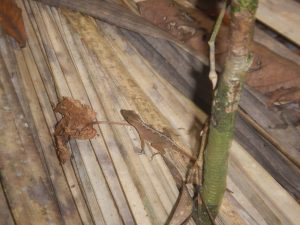
We then returned a little early for lunch, so we knocked out our lectures before eating. After a nice lunch and relaxation time, we went back out to collect the rest of our traps from the Monkey Tail Trail. These were a bit harder to find in the denser vegetation, and it took us a total of five and a half hours to cover about six kilometers because some of the camera traps were harder to find than others. I didn’t manage to see any more reptiles on this leg of our retrieval.
Our trap results were eventful. Most of the traps came up empty-handed, but a few of them showed us a large bird, some mammals, and even two ocelots! What a great way to top off an amazing trip. It won’t be easy to leave tomorrow.
To start the day, I did some birding, where we managed to see a strange, turkey-like bird called the Crested Guan. After breakfast we went back to the rainforest to collect our traps, which we spent the morning evaluating our data from the last 24 hours and writing it up as a poster.
After a nice lunch, we were determined to see as many different places in our vicinity as we could. To start, we went into the cave close to the research station, which was another former Mayan ritual site. In the cave we saw one Helmeted Iguana (Corytophanes cristatus), and one Neotropical Rat Snake (Senticolis triaspis). We didn’t go to far into the cave, but we went in for long enough for me and Ellie to give presentations on our taxon groups in what would have been pitch-black without our headlamps. When we came back from the cave, we spotted a Litter Gecko (Lepidoblepharis xanthostigma).
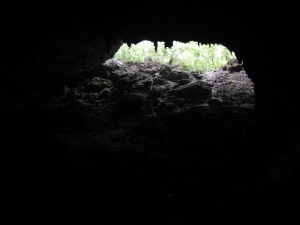
After caving we hiked up to the Bird Tower, a short but difficult hike that left us with a spectacular view to see the Chiquibul forest from all angles. Therese gave us a presentation of her research up there, and by the time we descended it was dark out. We took this chance to have a night hike back to the research station, right on time for a late dinner to top off the day.
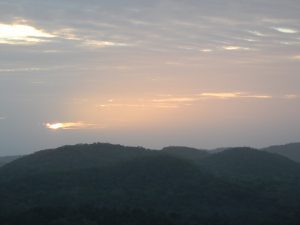
I started my day a little later today at 5:30 am (late is relative) for birdwatching, only to be greeted by two massive bug bites on my left ring finger, which have yet to go down. We didn’t see much until it was almost time for breakfast, when we saw two Scarlet Macaws nearby, which made for a nice treat. We ate at 6:30, and then got ready for our first experiment of the day. Our goal was to see if arthropod diversity and nutrient availability differed from the forest floor. This involved setting pitfall traps that included our own urine, which should be interesting when we go back for the vials tomorrow.

After that, we go to relax a bit before lunch and our second activity, where we went to leafcutter ant colonies of various sizes to dig in around the nests and see what they looked like inside. We were able to see the increase in complexity as the age of the colonies increased, as they got much bigger and had more pathways as they increased in age. Some paths in the nest were even wide enough that I could fit my whole arm in them. After returning and waiting for dinner, we saw even more macaws flying by.
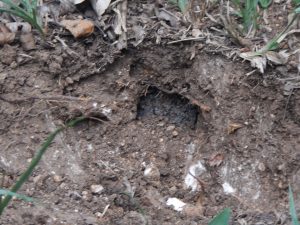
Unfortunately I didn’t manage to see any reptiles today. This was a disappointment, but I was beyond thrilled to have gotten the chance to see the macaws, which are incredibly beautiful and very rare. Now, I can only hope that my bites go away soon and that my finger can return to normal size.
We started our day early today for birdwatching, but the hazy morning made it difficult to spot much of anything. After a late breakfast at 7:30, we designed our first project of setting out camera traps to monitor predator and prey, hoping to spot a big cat or two when we collect the traps again in a few days.
We may have bitten off more than we can chew though; we set about half of our traps before lunch, and then went back out at 2:30 to set the rest of them. This involved going deep into the bush, though, and we did a little bit of accidental meandering that led us to return to the field station a full five hours after leaving and a bit after dark. This made for an interesting, dark, spider-filled walk back to the station. This means that we spent the high majority of today walking, something I haven’t done in a while.
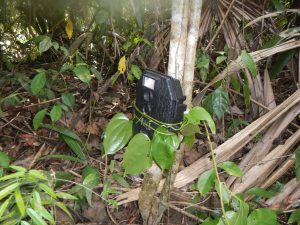
We managed to see a lot of reptiles today. This morning we spotted a Norops biporcatus, a green tree anole, and a Degenhardt’s Scorpion Eater snake, also known as Stenorrhina degenhardtii. In the afternoon we spotted a Plestiodon sumichrasti, a Sumichrast’s skink, a Norops lemurinus, or canopy anole, and even a small Bothrops asper, the notorious Terciopelo snake. Upon returning to the station, another group had found a Turnip-Tailed Gecko, also known as Thecadactyla rapicauda.
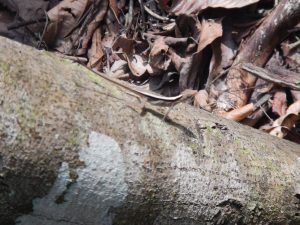
Our last consecutive day of travel finally led us to Las Cuevas, but not before some fun first. After departing from our nice lodgings and all internet access, we stopped at a nice river and waterfall area for a dip in the water. On the way there, we spotted a brown basilisk (Basiliscus vitiattus) from the van. The scenery was beautiful and the water was nice, and none of us wanted to leave. I spotted some kind of ameiva lizard there, but I didn’t have my ID card so I couldn’t pinpoint the species. We also enjoyed eating a soursop together, which was many peoples’ first time having one. This is one of the many perks of having islanders on this trip.
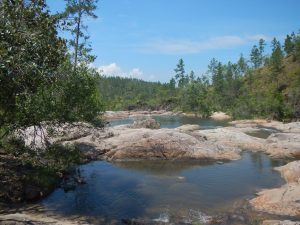
After swimming, we got back on the bumpy road to Las Cuevas, playing card games to pass the time in the van. We arrived at Las Cuevas around 1:15pm and were greeted by a delicious lunch. After settling in, we got a brief orientation and went for our first hike in the Chiquibul forest. We spent two hours walking through the forest, seeing lots of spider webs and even the vegetation-covered stones laid by Mayans over one thousand years ago.
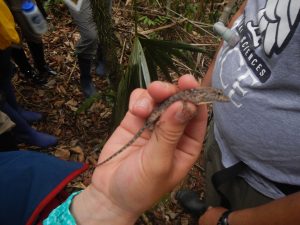
We spotted a Crested Anole (Anolis cristatellus) in the forest, but that was it for reptiles. We returned at 5:40, and spent time unwinding at the station. Since the rains have just started, we witnessed a termite nuptial flight, which some of us took as a chance to eat termites.
Bye Belize, bye cold showers, bye scarlet macaws, bye ticks, bye sand flies, bye erratic fear of bot flies, bye random sing along sessions, bye 10 mile hikes, bye rice and beans, bye Turez, bye SFS, bye Dory (again), bye beautiful ocean, bye pseudodiploria, bye ants, bye Apache, bye field notebooks, bye lectures, bye crabs, bye birds, bye trash crab, bye squishy, bye malfunctioning cameras, bye bug bite scars, bye stinky smell, bye unwashed clothes, bye Clivus, bye no internet, bye sharks, and bye EBIO 319.
Well, I am leaving Belize currently, on the plane right now, and that has not hit me yet. We started traveling from Las Cuevas to the airport early and made a pit stop for a gift shop. I don’t think any item can describe how I feel for this class. It has been great, but I guess I’ll reflect on that in my post class blog (coming soon).
This morning I finally woke up again for birding and I saw a scarlet macaw and some plumbeous kites. However, I was not super focused on the birding. I just sipped my coffee and talked to everyone because I won’t be waking up with all these people tomorrow. That’s super weird. I don’t like that.
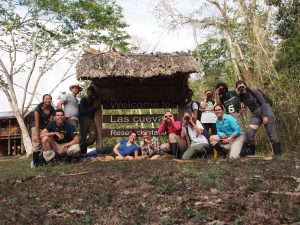
Well, I guess I have to come back to normal life at some point :/
On a happier note, still no ticks or chiggers!!!!!! I will have to thoroughly check when I get home, but I think I escaped it. To future TFBs, IT IS POSSIBLE!
It’s our last day in Belize 🙁 so today we went and picked up our camera traps we set three days ago. The hike really was not that bad this time and the suspense of discovering what we had on our traps was building.
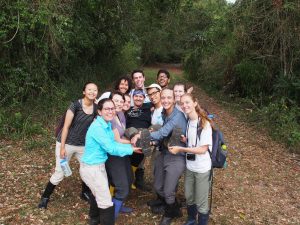
We viewed all 14 this evening and while most had nothing, we got a lot of cool species. Some highlights were 2 ocelots (one of which had a great photo), several pacas, a group of peccaries, a crochet deer, and a great currissow. The great currisow is this large funny looking bird with a black full plumage on its crest. Our most annoying camera to place did not get any photos, but overall I am pleased with the results.
On a bird note, I saw several Scarlet Macaws again today, but it’s funny how normalized this occurrence can become. That will be weird not hearing every day now.
AND THE BEST NEWS OF ALLL: ANNA 5- TICKS 0 !!! I also managed to escape the chiggers and I am very proud. Team parasite free!